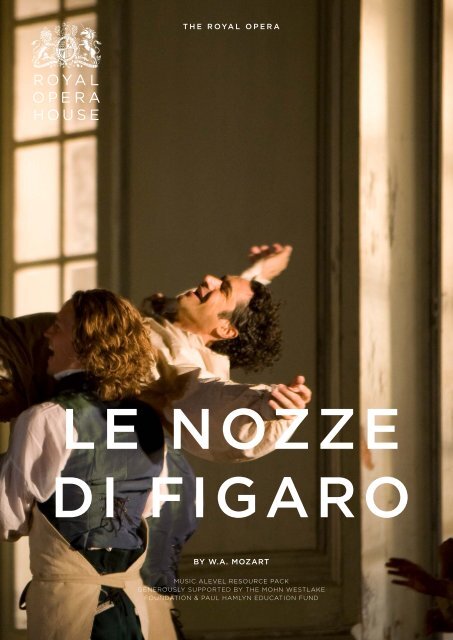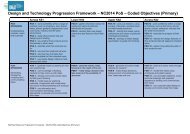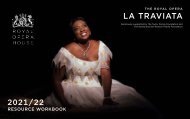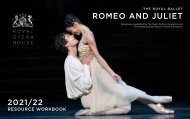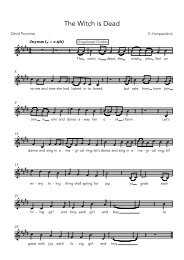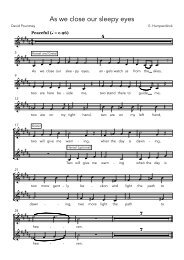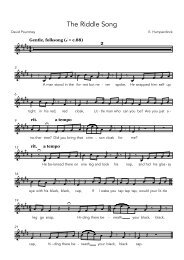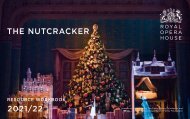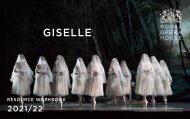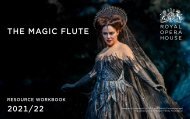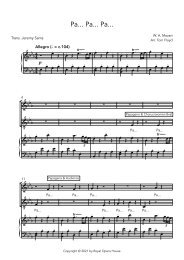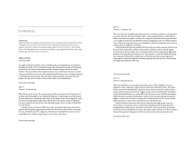ROH_Figaro_WebReadyDocument
- No tags were found...
Create successful ePaper yourself
Turn your PDF publications into a flip-book with our unique Google optimized e-Paper software.
THE ROYAL OPERA<br />
LE NOZZE<br />
DI FIGARO<br />
BY W.A. MOZART<br />
MUSIC ALEVEL RESOURCE PACK<br />
GENEROUSLY SUPPORTED BY THE MOHN WESTLAKE<br />
FOUNDATION & PAUL HAMLYN EDUCATION FUND<br />
1
4. INTRODUCTION<br />
6. THE MARRIAGE OF FIGARO<br />
10. THE MAKING OF AN OPERA<br />
12. THE DIRECTOR’S ROLE<br />
16. FIGARO’S ACT I ARIA<br />
20. MUSIC AS A DRAMATIC CHARACTER<br />
28. A DATE WITH CHERUBINO<br />
32. THE CONDUCTOR’S PERSPECTIVE<br />
36. WHY IS FIGARO SO POPULAR?<br />
40. PERFORMANCE NOTES<br />
2<br />
Ildebrando D’Arcangelo as<br />
<strong>Figaro</strong> © Bill Cooper<br />
3
Introduction<br />
Mozart<br />
In his short life of 35 years, Wolfgang Amadeus Mozart wrote 22 operas<br />
– penning his first at the tender age of 11. But it’s his trilogy of works<br />
with librettos by Lorenzo da Ponte that continue to delight audiences<br />
with their brilliantly absurd plots and sublime music in equal measure:<br />
Don Giovanni, Così fan tutte and Le nozze di <strong>Figaro</strong>.<br />
www.roh.org.uk/people/wolfgangamadeus-mozart<br />
About The Royal Opera House<br />
This resource features content and learning activities related to the<br />
Royal Opera House’s production of Le nozze di <strong>Figaro</strong>. The process<br />
of creating an opera is examined through the key roles of director and<br />
conductor, and the music from Act I is explored through cast interviews<br />
and listening, composition and performance learning activities. Students<br />
have the opportunity to consider the confluent storytelling forces at<br />
work in opera, and to reflect on the clever ways the opera serves as a<br />
comment on human nature.<br />
The Royal Opera House in London’s Covent Garden is home to two of<br />
the world’s great artistic companies, The Royal Opera and The Royal<br />
Ballet, performing with the Orchestra of the Royal Opera House. From<br />
here live performances are given almost every night of the week with<br />
12 productions each year relayed around the world through <strong>ROH</strong> Live<br />
Cinema, and with a wide range of activity streamed and shared online<br />
and through social channels.<br />
The Royal Opera, under the artistic direction of Antonio Pappano,<br />
Music Director, and Oliver Mears, Director of Opera, presents a<br />
wide-ranging programme including new commissions such as George<br />
Benjamin’s Written on Skin and Lessons in Love and Violence, Harrison<br />
Birtwistle’s The Minotaur and Mark-Anthony Turnage’s Anna Nicole<br />
and Coraline, as well as revivals and new productions of some of the<br />
key works in the opera repertory.<br />
The Royal Opera House also plays a leading role in the training of<br />
apprentices and emerging professional artistic talent as well as offering<br />
a national online learning and participation programme.<br />
Kishani Jayasinghe As Barbarina<br />
© Bill Cooper<br />
4<br />
Wolfgang Amadeus Mozart (1756–91)<br />
by Barbara Krafft (1764–1825), 1819<br />
The Royal Opera House auditorium<br />
© Rob Moore/<strong>ROH</strong> 1998<br />
5
The<br />
Marriage<br />
of <strong>Figaro</strong><br />
The Story<br />
Servants <strong>Figaro</strong> and Susanna plan to get married – but their master<br />
Count Almaviva has designs on Susanna and is determined to stop the<br />
Silhouettes of Francesco<br />
Benucci and Anna Storace,<br />
the first <strong>Figaro</strong> and Susanna<br />
wedding taking place. Meanwhile the page boy Cherubino’s passion for<br />
the ladies jeopardizes his job, and Countess Almaviva longs to regain<br />
her husband’s love.<br />
<strong>Figaro</strong>, Susanna and the Countess plot to shame the Count and save<br />
Cherubino from banishment. But their plans don’t run smoothly,<br />
particularly when the elderly Marcellina tries to force <strong>Figaro</strong> to marry<br />
her. An astonishing revelation prevents this happening, but will the<br />
Count still find a way to thwart the wedding? And can the Countess<br />
win back her husband’s affection?<br />
A glimpse of rehearsals for Le nozze di <strong>Figaro</strong><br />
www.youtube.com/watch?v=h00YBvXt4Vs<br />
6<br />
Barbara Frittoli As Countess Almaviva<br />
© Bill Cooper<br />
Le nozze di <strong>Figaro</strong>/David McVicar © <strong>ROH</strong><br />
7
Background<br />
Meet the characters<br />
Le nozze di <strong>Figaro</strong> was Mozart’s first collaboration with Lorenzo<br />
da Ponte, who also wrote the librettos for Don Giovanni and Così<br />
fan tutte. The opera is based on Pierre Caron de Beaumarchais’<br />
controversial play Le Mariage de <strong>Figaro</strong>. This play was banned in<br />
Vienna due to its potentially seditious content, and da Ponte had to<br />
excise much of its political content in order to get the opera accepted<br />
for performance. <strong>Figaro</strong> was a success in Vienna, and even more so in<br />
Prague, where Mozart reported ‘nothing but <strong>Figaro</strong>!’ was heard. It has<br />
remained one of the composer’s best-loved works.<br />
The score of Le nozze di <strong>Figaro</strong> is packed full of wonderful arias<br />
<strong>Figaro</strong> Cherubino Susanna<br />
Count Almaviva’s valet,<br />
Count Almaviva’s page boy<br />
Countess Almaviva’s<br />
engaged to Susanna<br />
maid, engaged to <strong>Figaro</strong><br />
covering a huge range of emotions, from the humour of <strong>Figaro</strong>’s ironic<br />
farewell to Cherubino (Non più andrai) to the poignancy of Dove sono,<br />
as the Countess remembers past happiness. The opera also contains<br />
remarkable ensembles, such as the closing scene of Act II, in which<br />
<strong>Figaro</strong>’s plans unravel at breakneck speed. As so often with Mozart,<br />
forgiveness is a key theme, and the Count’s Act IV plea to his wife,<br />
Contessa, perdono, is one of opera’s most moving moments. Stage<br />
director David McVicar sets The Royal Opera’s current production in<br />
a château in 1830 on the eve of France’s second revolution, exploring<br />
the political and class conflicts at the core of Beaumarchais’ play, but<br />
Count Almaviva Countess Almaviva Marcellina<br />
Lord of the Aguas<br />
Rosina, formerly the<br />
Dr Bartolo’s housekeeper<br />
Frescas estate, near Seville<br />
ward of Dr Bartolo<br />
also maintaining Mozart and da Ponte’s humanity and wit.<br />
8<br />
Le nozze di <strong>Figaro</strong> © Bill Cooper<br />
Ildebrando D’Arcangelo As <strong>Figaro</strong> © Bill Cooper<br />
Renata Pokupic as Cherubino © <strong>ROH</strong>/Mark Douet 2013<br />
Lucy Crowe as Susanna © <strong>ROH</strong>/Mark Douet 2013<br />
Christopher Maltman as Count Almaviva © <strong>ROH</strong>/Mark Douet 2013<br />
Maria Bengtsson as Countess Almaviva © <strong>ROH</strong>/Mark Douet 2013<br />
Ann Murray as Marcellina in Le nozze di <strong>Figaro</strong>, The Royal Opera © 2015 <strong>ROH</strong>. Photograph by Mark Douet<br />
9
The<br />
Making of<br />
an Opera<br />
Meet the team<br />
Director,<br />
Designer and<br />
Creative Team<br />
Props Staff<br />
Hundreds of people are involved in the process of making an opera.<br />
What kinds of roles are involved? Who takes part in running an opera<br />
rehearsal room?<br />
Music Staff<br />
Conductor, Assistant<br />
Conductor, Pianist, Language<br />
Coach, Music librarians<br />
Orchestra<br />
The rehearsal process for an opera production is long and complex.<br />
In the early rehearsals with the director, performers read through the<br />
language of the text as if it were a play. These reading rehearsals involve<br />
the cast, the director and creative team, the language coach and often<br />
the conductor. The musical elements begin to take shape in the initial<br />
music rehearsal or sitzprobe, a ‘sitting rehearsal’ run by the conductor<br />
and featuring the musicians – the soloists, chorus and orchestra. There<br />
are a number of different rehearsals that occur before and after the ‘sitz’.<br />
Singers work individually and in ensembles with members of the music<br />
department – the conductor, assistant conductor, pianist and language<br />
coach, as well as with other music staff who run rehearsals, coach and<br />
help with the preparation of instrumental parts.<br />
Stage Crew<br />
Management<br />
Set and<br />
Costume Makers<br />
Builders, Craftspeople,<br />
Scenic Artists, Costume<br />
Makers, Makeup, Wigs, etc.<br />
Cast<br />
Soloists and Chorus<br />
Technical<br />
Team<br />
The production gradually becomes more focused on staging, with<br />
staged piano, staged orchestral and dress rehearsals. After the final dress<br />
10<br />
rehearsal, the production becomes ‘frozen’ – that is, what was done in the<br />
final dress rehearsal is performed in the same way on the opening night.<br />
Helene Scheiderman as Marcellina © <strong>ROH</strong>/Mark Douet 2013<br />
David McVicar © KK Dundas/RCS 2012<br />
Transferring markings in the music library © <strong>ROH</strong><br />
© Sim Canetty-Clarke/<strong>ROH</strong> 2012<br />
© Sim Canetty-Clarke/<strong>ROH</strong> 2012<br />
© Sim Canetty-Clarke/<strong>ROH</strong> 2012<br />
© Sim Canetty-Clarke/<strong>ROH</strong> 2012<br />
Le nozze di <strong>Figaro</strong> © <strong>ROH</strong>/Mark Douet 2013<br />
© Sim Canetty-Clarke/<strong>ROH</strong> 2012<br />
11
The<br />
Director’s<br />
Role<br />
Find out how a director works by reading this<br />
transcript of a discussion with stage director<br />
Thomas Guthrie, who revives the <strong>ROH</strong><br />
production of The Marriage of <strong>Figaro</strong> in 2019<br />
An opera is delivered by a creative team – this includes the director,<br />
set designer who creates the set and costumes, lighting designer,<br />
choreographer and the conductor. The director plays a key role in the<br />
production of an opera. It is the director who works with the creative<br />
team – performers, production designer, conductor, choreographers<br />
and lighting designers – using all the means at their disposal to be a<br />
storyteller and engage and entertain their audience.<br />
A director works extensively with lead performers to help them inhabit<br />
their roles on stage – to really ‘be’ their character without having<br />
to think or worry too much. The director might ask the performers<br />
detailed questions about their character, both about their backstory<br />
(‘where was I born?’, ‘what did I want to do with my life?’) as well as<br />
more immediate questions (‘what am I wearing today?’, ‘how long have<br />
I got in this scene?’). These nuances are important in understanding and<br />
projecting the depth of the character. For example, the name ‘<strong>Figaro</strong>’<br />
is a rather unusual one; from where does it originate? The theory is<br />
that the name comes from ‘fils Caron’, which literally means ‘son of<br />
Caron’, and which, when said quickly, does sound a bit like ‘<strong>Figaro</strong>’.<br />
Beaumarchais, the original play’s author, was indeed the son of one<br />
André-Charles Caron, which implies that the character <strong>Figaro</strong> is in<br />
fact a version of Beaumarchais himself, and as such, being a member<br />
of the working class, was suspicious of authority. This gives more of a<br />
backstory, and injects more meaning into the role of <strong>Figaro</strong>, enabling the<br />
Mariusz Kwiecienńin Le nozze di <strong>Figaro</strong><br />
© Clive Barda/<strong>ROH</strong> 2011<br />
performer to inhabit him more fully.<br />
12<br />
Backstage © Sim Canetty-Clarke/<strong>ROH</strong> 2012<br />
Thomas Guthrie © Theresa Pewal<br />
13
Activity 1: Reflection Questions<br />
How does the director bring the opera to life?<br />
What types of decisions do they have to make?<br />
How might the director work with the music? The music often serves to<br />
further the storytelling – how might they work to support this dramatically?<br />
What types of personal skills might a director have to have?<br />
Le nozze di <strong>Figaro</strong>/David<br />
McVicar © <strong>ROH</strong><br />
14<br />
Production Image - Le nozze di<br />
<strong>Figaro</strong> at The Royal Opera House<br />
2015. Photo by Mark Douet<br />
15
<strong>Figaro</strong>’s<br />
Act 1<br />
Aria<br />
‘Now just how does a plot<br />
get furthered by music? Well<br />
there are a number of ways;<br />
there’s ballet, underscoring,<br />
choral devices and so on, but<br />
certainly the most common<br />
technique for telling your<br />
story musically is the device<br />
known as recitative...’<br />
Leonard Bernstein, Conductor<br />
In The Marriage of <strong>Figaro</strong>, characters sing both recitatives and arias.<br />
In a recitative, passages of dialogue are performed in a semi-sung,<br />
semi-spoken way using the rhythms and features of ordinary speech.<br />
While represented on the page in traditional musical notation,<br />
performers are free to interpret phrases at will, assisted by skeletal<br />
chordal accompaniment from a keyboard instrument. Recitatives<br />
are often where the action happens – quarrels occur, stories are told,<br />
characters confess secrets – and so their purposes are varied; to further<br />
the storyline, to present conversations between characters or even to<br />
enable a harmonic transition to a new key.<br />
The action and forward momentum generated by recitatives contrast<br />
with the more reflective and lyrical arias with which they are typically<br />
alternated. In these formalised songs, solo characters reflect on their<br />
situation, emotions and motives, often with much repetition of text<br />
and phrasing. Arias give singers the chance to demonstrate the extent<br />
of their vocal capabilities, and are accompanied by the full orchestra.<br />
The nature of operatic story-telling means that characters sing both<br />
recitatives and arias, often in a seamlessly flowing musical progression.<br />
The audience can connect with characters at a more literal, dialoguelevel<br />
while empathising with their emotional situation at significant<br />
points in the storyline.<br />
16<br />
Erwin Schrott in Le nozze di <strong>Figaro</strong><br />
© 2015 <strong>ROH</strong>. Photograph by Mark Douet<br />
17
Activity 1: Reactive Interpretation<br />
(Bravo, signor padrone)<br />
On your score, follow <strong>Figaro</strong>’s recitative<br />
(Scene II, <strong>Figaro</strong> solo, immediately prior to No. 3 Cavatina).<br />
Notice and mark in the details of Simon’s interpretation of the text<br />
in terms of:<br />
- Rhythmic flexibility<br />
- Accented vocal syllables<br />
- Vocal tone and colour variance<br />
- Any other interesting features<br />
How do these interpretative decisions reflect the character and<br />
moods of <strong>Figaro</strong>?<br />
Activity 2: Harmonic analysis<br />
(Bravo, signor padrone)<br />
Baritone Simon Shibambu discusses his interpretation of the role of <strong>Figaro</strong><br />
www.youtube.com/embed/JnrtskoZ2fo<br />
Analyse the chords and harmonic changes which accompany <strong>Figaro</strong>’s<br />
brief recitative. Depending on your score, you many need to interpret the<br />
chords by ‘filling in the gaps’ using <strong>Figaro</strong>’s melody and your aural skills.<br />
How has Mozart used specific chordal changes to convey the meaning<br />
and emotions of the text? To what extent are these affected by<br />
individual singers’ interpretations?<br />
Activity 3: Character Portrayals<br />
Watch the YouTube examples of staged performances of the recitative<br />
Bravo, signor padrone listed later in this resource, and compare with<br />
Simon’s performance in the video. Discuss your observations of different<br />
character portrayals - are they both the same type of <strong>Figaro</strong> or are there<br />
two different interpretations of his character?<br />
Give reasons to support your answer.<br />
No. 3 Cavatina (<strong>Figaro</strong> - Se vuol ballare)<br />
Conductor James Hendry discusses <strong>Figaro</strong>’s aria<br />
www.youtube.com/embed/qJluDkjg9-4<br />
Annotate your score with the points James makes, referring to:<br />
- The horn calls<br />
- The use of pizzicato strings<br />
- The scalic melodic contour embellished in contrasting sections<br />
Activity 4: Analysis and Composition<br />
Explore Mozart’s use of melody, harmony and instrumentation in the<br />
two contrasting themes of Se vuol ballare. Mark your observations on<br />
the score.<br />
Experiment with composing your own two-part Cavatina (‘little song’)<br />
which uses a particular melodic idea linking both sections. You might,<br />
like Mozart, chose to use a scale or experiment with arpeggios, melodic<br />
motifs or intervals. Flesh out your ideas by exploring instrumentation<br />
and textures within a Classical style.<br />
18<br />
19
Music as<br />
a Dramatic<br />
Character<br />
‘Opera is the embodiment of<br />
an essential human instinct:<br />
telling stories through music…<br />
Since the principal language<br />
of opera is music, and music<br />
is essentially an abstract<br />
language, it cannot be a<br />
tool for explicit political or<br />
even emotional ideas, but it<br />
does express emotional and<br />
imaginative truths that lie<br />
behind material realities.’<br />
David Poutney, Opera Director<br />
Opera is considered to be the most thrilling of art forms, with its<br />
immersive combination of music, drama, storytelling, dance and design.<br />
At its best, opera is wonderfully powerful and emotionally direct,<br />
offering the audience reflections on what it means, individually and<br />
collectively, to be human.<br />
Music plays an integral role in opera. From the very first moment of<br />
a live performance, it is music that connects us with the characters<br />
and setting, music that moves us, that drives the story forward and<br />
supports our emotional journey as the plot unfolds. In opera, it is the<br />
music that provides the seamless transitions between scenes, between<br />
conversational and reflective moments, and between recitative passages<br />
and arias.<br />
The expressive potential of text set to music is significant. Composers<br />
have a huge degree of control over the emotional flow of the storyline,<br />
and make careful musical decisions in order to move beneath the surface<br />
of what is being expressed lyrically, so deeper emotional terrain is<br />
explored. As the audience follows characters on their various journeys,<br />
the music provides moments of pause, allowing for an exploration of<br />
challenging human emotions – love, despair, jealousy, fear, hope.<br />
20<br />
Carlo Lepore as Bartolo in Le nozze di <strong>Figaro</strong><br />
© Bill Cooper/<strong>ROH</strong> 2012<br />
Anita Hartig in Le nozze di <strong>Figaro</strong><br />
© 2015 <strong>ROH</strong>. Photograph by Mark Douet<br />
21
The Overture<br />
Activity 3: Composition<br />
James discussing the overture<br />
www.youtube.com/embed/n0lMBlStq-4<br />
Imagine the type of busy household you might set an opera in.<br />
Using Mozart’s overture as inspiration, compose your own opening<br />
which could suggest it musically. You might like to include characters/<br />
themes such as:<br />
Activity 1: Overture Comparison<br />
Listen to the very opening of some of Mozart’s other opera overtures<br />
and compare them with the opening of The Marriage of <strong>Figaro</strong>.<br />
For example, you might listen to:<br />
- Don Giovanni<br />
- Così fan tutte<br />
- The Magic Flute<br />
- La Clemenza di Tito<br />
- Servants – maids, butlers, cooks, gardeners…<br />
- Lords, ladies and other members of the ruling class<br />
- Children running around - upper or lower class<br />
- Animals<br />
- Guests – visitors, members of the clergy<br />
How can you use musical elements to explore the intertwining lives<br />
of these people?<br />
How are the various musical elements utilised for particular dramatic effect?<br />
Activity 2: Analysis and Interpretation<br />
In James’ interpretation, the opening of the overture could represent the<br />
different social groups in the household – the hustle and bustle of the<br />
busy servants, the more noble, regal airs of the ruling class…<br />
On your score, examine the opening to Mozart’s overture and note the<br />
specific musical features which could reflect these elements. Are there<br />
other interpretations you could draw from the music alone? What might<br />
Mozart’s intentions have been? Be creative!
No. 1 Duettino - <strong>Figaro</strong> and Susanna<br />
Recitative<br />
(Cinque... dieci... venti)<br />
James dicussing the duet<br />
James discussing recitative<br />
www.youtube.com/embed/ykWDxVzQ75Y<br />
www.youtube.com/embed/9y9APxtVmOA<br />
Annotate your score with the points James refers to.<br />
Are there any other nuances you notice in this musical conversation?<br />
Activity 1: Production Comparison<br />
Although the music and text remain the same, different productions of<br />
The Marriage of <strong>Figaro</strong> vary in their portrayal of the characterisation<br />
and interactions between <strong>Figaro</strong> and Susanna. Explore the ways different<br />
directors have depicted the opening dynamic between the two characters.<br />
Here are some YouTube examples, although there are many more:<br />
Alison Hagley as Susanna and Gerald Finley as <strong>Figaro</strong> (Glyndebourne, 1994)<br />
www.youtube.com/watch?v=kY9gSwBWj6E<br />
Activity 2: Comparison<br />
As James suggests in the video, compare different performances of a<br />
recitative in terms of accompaniment style. Some questions to consider:<br />
Which instruments are used? Is it a solo keyboard instrument or are<br />
there others also? What roles do they play?<br />
How ornate and busy is the accompaniment? Or does it tend to be<br />
simpler and sparser? Is there a combination of both?<br />
Specifically, what kinds of ornaments and embellishments do you hear?<br />
You might like to compare different accompaniments of the brief<br />
recitative you studied in the last chapter, which appears immediately<br />
before <strong>Figaro</strong>’s Se vuol ballare. It begins with Bravo, signor padrone!<br />
Some clips that could be used for comparison are:<br />
Marlis Petersen as Susanna and Ildar Abdrazakov as <strong>Figaro</strong> (Metropolitan Opera, 2014)<br />
www.youtube.com/watch?v=kPkQP2gwyzM<br />
Bryn Terfel as <strong>Figaro</strong> from 1:40<br />
www.youtube.com/watch?v=W1i0GGnMPaI&feature=youtu.be<br />
Rosemary Joshua as Susanna and Luca Pisaroni as <strong>Figaro</strong> (Théâtre des Champs Elysées, Paris, 2004)<br />
www.youtube.com/watch?v=Spt_3Q_gPAs<br />
Ildebrando D’Arcangelo as <strong>Figaro</strong> from 12:57<br />
www.youtube.com/watch?v=_OYtlGpApc0&t=456s<br />
Alison Hagley as Susanna and Bryn Terfel as <strong>Figaro</strong> (Théâtre du Châtelet, Paris, 1993)<br />
www.youtube.com/watch?v=Ew571WMgrdg<br />
Ferruccio Furlanetto as <strong>Figaro</strong><br />
www.youtube.com/watch?v=WxhjLZnAZj8
Activity 3: Recitative Performance<br />
Experiment with performing <strong>Figaro</strong>’s brief recitative Bravo, signor<br />
padrone. Suggested steps include:<br />
Listen to performances a number of times while following your score.<br />
You might like to use the text and translation below.<br />
Mark in the expressive nuances you notice (accents, pauses, dynamic<br />
changes, vocal tone changes). What different emotions might <strong>Figaro</strong> be<br />
experiencing?<br />
Experiment with speaking the text in style – in Italian or English – while<br />
the keyboard accompaniment is played. Focus on storytelling – how<br />
expressive can you be with your use of language, timing and musicality?<br />
Experiment with singing part or all of the text at pitch with keyboard<br />
accompaniment. You might like to choose a couple of phrases and<br />
explore different ways of performing them.<br />
Josephine Veasey and Graziella Sciutti in<br />
the Covent Garden Opera Company 1965<br />
revival of Le nozze di <strong>Figaro</strong> (1963)<br />
27
A Date<br />
with<br />
Cherubino<br />
‘Cherubino is a page-boy…<br />
more of a teenager and he<br />
helps around the house, he<br />
attends to duties now and<br />
again but the most important<br />
thing to say about Cherubino<br />
is that he’s desperately in<br />
love with the Countess.’<br />
Angela Simkin, Mezzo-Soprano<br />
Cherubino is a charming nuisance. He is the Count’s page boy and,<br />
as a pubescent teenager, is coming to terms with his hormones – he<br />
has crushes on most of the women in the palace, particularly on the<br />
Countess. Cherubino is a trouser role, meaning that his part is sung<br />
and acted by a female mezzo-soprano. Trouser roles are sometimes<br />
Hear Angela discussing the role of Cherubino<br />
www.youtube.com/embed/JJiv5cQvn5c<br />
used in opera when portraying adolescents and very young men,<br />
and historically were of particular fascination to the audience, who<br />
marvelled at women showing their legs in breeches (tight-fitting knee<br />
length trousers).<br />
The character of Cherubino is a particularly energetic, awkward and<br />
endearing character in the story and his presence is frequently the<br />
subject of chaos. As such, a comic character like his contributes to the<br />
twists and turns of the plot significantly.<br />
28<br />
Barbara Frittoli as Countess Almaviva and<br />
Anna Bonitatibus as Cherubino © Bill Cooper<br />
29
Activity 1: Characterisation<br />
How might you introduce a trouser role like Cherubino?<br />
How could you use music to portray aspects of his personality?<br />
Comment under the musical elements’ headings.<br />
- Melody<br />
- Harmony<br />
- Tonality<br />
- Structure<br />
- Sonority (timbre)<br />
- Texture<br />
- Tempo, metre and rhythm<br />
- Dynamics and articulation<br />
You might like to experiment by composing the beginning of your own<br />
piece which introduces Cherubino using your ideas from above.<br />
How many features of Mozart’s style can you incorporate within<br />
your own composition?<br />
No. 6 Cherubino’s Aria - Non so più<br />
Activity 2: Performance anaylsis<br />
Play and/or sing the last nine bars of the aria, focusing especially on<br />
Mozart’s crunchy harmonies. Determine which chords and inversions<br />
are used. Perhaps experiment with using different inversions – how do<br />
they affect the expressiveness of the chord progression?<br />
Activity 3: Comparison essay question<br />
In Cherubino’s first aria Non so più he is energetic, passionate and<br />
tormented. Later in the opera, he is cajoled into singing his song for the<br />
Countess (Voi che sapete) and is timid, embarrassed and slightly flirtatious.<br />
How does Mozart portray these emotional states in terms of musical<br />
elements? Discuss with reference to both arias.<br />
Cherubino’s other aria Voi che sapete<br />
www.roh.org.uk/news/accessible-arias-voi-che-sapete<br />
30<br />
Renata Pokupic as Cherubino<br />
© <strong>ROH</strong>/Mark Douet 2013<br />
31
The<br />
Conductor’s<br />
Perspective<br />
‘A champagne-like evening<br />
full of froth and vigour but<br />
it’s also got the great depth<br />
to really touch the soul.’<br />
Ivor Bolton, Conductor<br />
In shaping the musical elements of an operatic production, no one has<br />
a more influential role than the conductor. After all, it can be said the<br />
story of an opera is invariably expressed more fully in the music than in<br />
the words.<br />
The practicalities during performance mean that the conductor has a<br />
highly directive role by necessity – after all, the orchestra in the pit is<br />
sometimes unable to hear the singers on stage and vice versa. However,<br />
it is during the production process that key musical decisions are made,<br />
interpretations are developed, and where relevant decisions regarding<br />
alternative versions are made. The conductor needs to learn the score<br />
inside-out and develop a concept of what the composer intended. They<br />
Ivor Bolton talks about the power of the music in opera<br />
www.roh.org.uk/news/watch-members-of-thecast-and-creative-teams-on-le-nozze-di-figaro<br />
also need to consider the score as a narrative device for the story being<br />
told, and then communicate their interpretation, inspiring the musicians<br />
while giving them space to perform at their best.<br />
The conductor is responsible for a number of different types of<br />
rehearsals prior to performance. As well as the sitzprobe, or first<br />
music rehearsal featuring the cast and orchestra, conductors run music<br />
rehearsals, in which the sole concern is the singing and music.<br />
They might also coach the soloists in smaller settings.<br />
The assistant conductor is also involved in the production process,<br />
attending and running rehearsals and filling in for the conductor in<br />
32<br />
Christopher Maltman as Count Almaviva<br />
some performances.<br />
33<br />
© <strong>ROH</strong>/Mark Douet 2013
‘Almost everything is stepwise<br />
motion. Slithering and<br />
chromatic, it conjures up<br />
a world of intrigue. This<br />
overture is exceptional in<br />
its capacity to conjure up<br />
the sense of the drama to<br />
follow, in its precision, its<br />
atmosphere, its brilliance<br />
and virtuosity.’<br />
Ivor Bolton, Conductor<br />
‘What makes this opera so<br />
unique is that we have a series<br />
of what are seemingly stock<br />
characters, but in the hands<br />
of Mozart and da Ponte, the<br />
music and the drama are<br />
intertwined in such a way that<br />
the characters become deeper,<br />
broader and far more human.’<br />
Leah Hausman, Revival Director<br />
34<br />
Guy de Mey as Don Basilio in Le<br />
nozze di <strong>Figaro</strong>, The Royal Opera<br />
© <strong>ROH</strong>/Mark Douet 2014<br />
35
Why is<br />
<strong>Figaro</strong> so<br />
Popular?<br />
‘To see humanity socially, for<br />
Mozart, is to see it comically,<br />
completely shorn of heroic<br />
stature. But it is also to see<br />
it how it is, and not as it<br />
somehow ought to be.’<br />
Gregory Dart, Musicologist<br />
For Gregory Dart, Le nozze di <strong>Figaro</strong>, his favourite opera, holds special<br />
meaning. The magic of the opera lies in Mozart’s extraordinary ability<br />
to explore the serious through the comic, the profound through the<br />
farcical, as society becomes the lens through which these are examined.<br />
As the opera progresses, the apparently chaotic farce cleverly becomes<br />
profound and moving, as moments of touching emotive truth are<br />
underpinned by exquisite music. And, as Dart explains, it is the music<br />
which drives the audience towards these discoveries, with frequently<br />
contradictory expression between text and music hinting at deeper,<br />
and often more real, moments of character expression. While the text<br />
presents characters as selfish and narrow, the music shows the reserves<br />
of generosity and honour that lie beneath the surface. The story is lifted<br />
out of the bedroom and becomes unexpectedly poignant and telling.<br />
Musicologist Gregory Dart provides<br />
insight in his article Beauty and Truth,<br />
written for the programme book<br />
Alexandra Kurzak as Susanna in Le nozze<br />
de <strong>Figaro</strong> © Bill Cooper/<strong>ROH</strong> 2012<br />
© Vibeche Dart<br />
For Dart, it is the ensemble numbers that hold the key to the opera,<br />
as the chaos of Act II begins to reveal the interconnectedness between<br />
the individual and society. This is apparent as the opera explores with<br />
poignancy and tenderness, not just <strong>Figaro</strong> and Susanna’s marriage,<br />
but also the jealous, suspicious and restless marriage of the Count<br />
and Countess. Cherubino’s presence is also a source of meaning –<br />
simultaneously an annoyance, a challenge and a hope.<br />
Samuel Ramey, Marie McLaughlin and Diana<br />
36<br />
Montague in The Royal Opera 1982 revival<br />
Le nozze di <strong>Figaro</strong> (1970)<br />
37
Activity 1: Reflection Questions<br />
Do any elements of this interpretation resonate with you? How so?<br />
Are there any inferences and opinions you disagree with?<br />
Can you find any specific moments in the opera which to you hint at<br />
contradictory textual and musical meanings? What is the effect of these<br />
contradictions?<br />
Which character do you relate to most in the opera? Are there moments<br />
when they are presented as a comment on the human condition?<br />
38<br />
Alexandra Kurzak as Susanna in<br />
Le nozze de <strong>Figaro</strong> © Bill Cooper/<strong>ROH</strong> 2012<br />
39
Performance<br />
Notes<br />
A history of the performance of Mozart’s<br />
Le nozze di <strong>Figaro</strong> at the <strong>ROH</strong><br />
Ildebrando D’Arcangelo as <strong>Figaro</strong><br />
© Bill Cooper<br />
Christopher Maltman as Count Almaviva<br />
© <strong>ROH</strong>/Mark Douet 2013<br />
The first English performance of Le nozze di <strong>Figaro</strong> was at the King’s<br />
Theatre in London in 1812, sung in Italian. It was first performed at<br />
Covent Garden (in English) in 1819. Mozart’s music was rearranged and<br />
additional items were composed by Henry Bishop. Performed regularly<br />
at Covent Garden in the 19th and 20th centuries, it was first performed<br />
by The Covent Garden Opera Company (what is now The Royal<br />
Opera) in 1949. Since then, there have been a number of productions<br />
and subsequent revivals with internationally renowned artists.<br />
40<br />
41
Activity 1: Research<br />
How did Mozart’s audience and context shape Le nozze di <strong>Figaro</strong>?<br />
Research the following points:<br />
Audience: What type of audience was Mozart writing for? What might<br />
his purpose have been – to entertain, educate, make money, create<br />
great art…? Where were operas performed in Mozart’s time and how<br />
were they typically received? What might the audience’s response to<br />
Le nozze di <strong>Figaro</strong> have been?<br />
Time: What were some social/political issues at the time of Mozart’s<br />
writing? How might they have had an impact on the opera’s creation<br />
and performance?<br />
Place: Where was the opera created? What influence might the<br />
place have had on the creation, development and performance of<br />
Mozart’s opera?<br />
Activity 2: Class Discussion<br />
Consider the different production photos.<br />
What changes in interpretation, character and setting do you notice?<br />
What factors might have influenced these changes?<br />
42<br />
© Sim Canetty-Clarke/<strong>ROH</strong> 2012<br />
43
SCHOOLS’ RESOURCE PACK<br />
FOR A LEVEL STUDENTS<br />
© <strong>ROH</strong>, SEPTEMBER 2018<br />
GENEROUSLY SUPPORTED BY<br />
THE MOHN WESTLAKE FOUNDATION<br />
& PAUL HAMLYN EDUCATION FUND<br />
44


